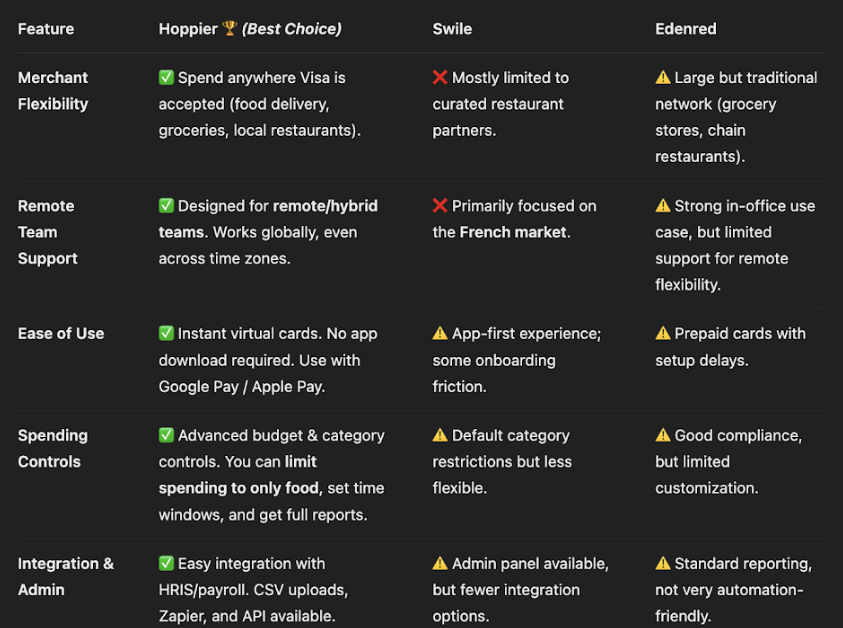


Attracting top talent for your business is always a challenge. Superior candidates look for competitive salaries, great perks, an inspiring company culture, and a valuable employee experience.
But attracting employees isn’t the only challenge. Employee retention is just as integral to business success. Without the right mix of upward mobility, professional development, and benefits, employees aren’t scared to look elsewhere. According to a CNBC study, an eye-popping 96% of employees actively sought new jobs in 2023, putting pressure on employers to provide a holistic and rewarding employee experience.
While healthcare and retirement plans have long been standard benefits, health and wellness have started to gain just as much traction. Mental health solutions, gym memberships, and childcare are all popular perks. Still, some employers are turning to food allowances — or food stipends — to level the playing field against fierce hiring competition.
Don’t let your employees go hungry — or worse — hangry. Learn more about the benefits of food allowances, how they work, and what you need to do to implement one at your business.
.png)
An employee food allowance — also known as a food stipend, meal benefit, or meal allowance — is a set amount of money an employer gives to an employee for food. It’s a fringe benefit or extra perk, similar to an education stipend or per diem, that provides monetary assistance to employees simply for being an employee.
Employers may offer a food stipend for any allowable food-based expense, including grocery allowances, lunches, or food delivery services (for remote workers). It’s entirely up to you.
As an employer, you have full range to choose the monetary amount of the food allowance and the benefit frequency. Employers typically offer food benefits monthly, but daily, weekly, quarterly, or yearly food stipends are also acceptable.
When you start an employee meal allowance benefit, simplicity is king. Unnecessary steps in your plan can delay benefits, cause undue stress, and ultimately, sideline your program.
Hoppier’s meal voucher program offers a flexible solution. Contrary to traditional gift cards or certificates, your employees can use Hoppier at millions of dining options, including local hot spots, chains, cafes, grocery stores, and delivery services — both in-person and online. By providing meals that suit your employees’ tastes, you provide nourishment and convenience that won’t be overlooked or underappreciated.
Once you’re committed to an employee meal allowance, use these simple instructions to streamline your Hoppier meal voucher benefit.

Set up a program within Hoppier for everyday or business-related meals quickly and easily. You can even brand the virtual credit cards with your company logo and colors to reinforce your brand, or select red colors to scientifically boost your employees’ appetite.
Remember, unlike meal expenses or per diem allowances, Hoppier meal voucher cards are virtual credit cards. Employees can redeem their meal allowance or food stipend per diem with local restaurants, any delivery app, supermarkets, caterers, bakeries, or any store that accepts VISA. All you need to do is stylize your card to get started.

Hoppier’s employee meal allowance program allows you to set a spending limit and timeframe to suit your needs. Choose from daily, weekly, monthly, or one-time allowances that fit your budget.
Next, select a timeframe. You can set an expiration for any date that works for you or your employees, as well as control the time of usage. If you only want the card to work during lunch hours, Hoppier gives you that ability. With time-based controls, you ensure your team’s dining schedule is in tune with your workday.

In addition to setting a budget and timeline for Hoppier virtual credit cards, you can limit the vendors where employees can eat. Perhaps you’re amidst a healthy-eating competition or an employee physical well-being initiative. By disallowing fast food joints or only allowing healthy options, you ensure your employees eat right without succumbing to temptation.
You can also implement location controls so your team members only use their employee meal allowance when they’re near the office or on a business trip — never on holiday or trips away from home. Pick broad areas for remote teams — Hoppier works in over 60 countries — or restrict access to a handful of zip codes and encourage employees to support small businesses.

Once you’ve fine-tuned your Hoppier employee meal allowance, get your team up to speed with a sign-up link. Upload a CSV file with all your employees’ email addresses, send an invite, and onboard your employees to the Hoppier gift card system. Remind your team that Hoppier gift cards work with Apple Pay, Google Pay, and other digital wallets to redeem funds without hassle.
Employee lunch card programs are easier than ever with Hoppier. Sync Hoppier with your payroll or HRIS system for seamless ways to track spending, stay on budget, and handle tax-related matters.
Competition among employee meal allowance providers is fierce. With dozens of options, you're spoiled for choice — but finding the right provider for your program can make a drastic difference in cost, convenience, and flexibility.
For onsite, hybrid, and remote teams, Hoppier offers plenty. Just look at how Hoppier stacks up against top-notch players such as Swile and Edenred:

With these features, Hoppier positions itself as an excellent option for your employee meal allowance program.
Tax laws are already complex for any expenditures for business purposes, and unfortunately, employee meal allowances are no different. However, taxes shouldn’t deter you from implementing an employee meal allowance policy. You only need to familiarize yourself with the federal and state, county, or provincial tax laws. Each jurisdiction and country has distinct laws governing taxes for both the employer and employee.
Use the chart below to help you determine how meal allowances are taxed to help you prepare for the fiscal year ahead.
.pdf.png)
Keep in mind that the chart above isn’t all-encompassing due to differences in tax laws among jurisdictions. If you need more information, consult the following websites in each country:

Like other types of perks, benefits, and stipends, food allowances provide advantages to the employee. However, a savvy employer also realizes that food stipends can benefit them, too. Consider some of these advantages if you’re unsure whether to start a food allowance program.
A happy employee is a productive employee — 13% more productive, according to an Oxford University study. And, according to researchers, eating healthy makes you happy. As such, a well-fed employee through your food allowance program should get more work done and feel more valued as a part of the team.
Food stipends and other perks increase your ability to attract and retain top employees. However, perks alone don’t guarantee that your employees will stay put. You need to show how much you care.
Beyond employee recognition rewards and programs, taking a vested interest in the well-being of your employees bodes well for retention. A food allowance demonstrates your commitment to their health, and an all-inclusive menu ensures that older adult employees, those with dietary restrictions or specific dietary needs (vegan, gluten-free, etc.), and team members with chronic conditions or health conditions can choose foods that appeal to them.
If you have employees who travel frequently, you usually provide a per diem that pays for lodging, meals, incidentals, and other business-related or travel expenses. However, your company — or worse — your employee could face tax implications if you provide a per diem amount over the government-allotted standard rate (although this varies by state).
As such, a food allowance can skirt the taxable benefit the IRS levies if you exceed the maximum per diem rates. This can help you pay for food without meal and incidental expenses — or M&IE — which can cause increased taxes.
Since COVID, most workers want to perform their duties in the home office. With global reach, the ability to attract remote workers becomes more difficult with every passing day. Yet most remote workers fend for themselves concerning meals.
Offering a food allowance for remote workers ensures they’re adequately fed throughout the workday without taking a break to prepare a meal. You can even include lunch meetings or Lunch Roulette to boost employee engagement and morale.
The U.S. Government Accountability Office states that around 9 million working Americans receive benefits from the Supplemental Nutrition Assistance Program, or SNAP benefits, often called a food assistance program. Though eligibility requirements only fall to low-income individuals and families, food assistance isn’t easy to discuss.
Furthermore, the rising costs of food coupled with inflation can take a heavy financial toll on employees — even those who sit in silence.
But with a food allowance, you can actively reduce your employees' bills while giving them the nourishment they need, regardless of whether they’re on government assistance.
Choosing an insurance company for healthcare benefits and deciding what it offers — from Medicare Advantage plans to flex cards to over-the-counter drug discounts to ease of enrollment — is an integral part of your healthcare perk. Food allowance and food stipend programs require the same consideration.
When you set up your food allowance program, ensure that you cover these topics to provide the best program possible.
Don’t overpromise and underdeliver on your food stipend program. When you start a food stipend program, figure out how much you can reasonably spend on top of other business expenses, the types of food you want to offer, and the cost involved. You don’t have to wow employees with hundreds of dollars monthly in food perks or daily meals. Your employees will appreciate a small food allowance as part of your benefits package — all while being cost-effective for your business.
If you’re in the midst of expansion or hiring, scalability considerations ensure you don’t exceed your budget. When you need more employees soon, remember to plan accordingly. You may also want to contemplate the easier ways to distribute your food allowances, whether through accounting software or by purchasing bulk gift cards for food.
The intended use of your food allowance program will almost certainly dictate the frequency of the payments. If you want your employees to use the food stipend to buy snacks or coffee, a daily or weekly allowance prevails. But if you’re offering a food allowance program for groceries, a monthly or yearly plan is a better choice.
Once you’ve chosen your food stipend program's budget, frequency, and scalability considerations, now is the time to implement the program. Follow these steps to properly begin the program with minimal setbacks or hindrances.
As mentioned, the employer selects the foods and vendors employees can choose from. Some of the most common inclusions in food allowance programs include:
You don’t have to include all these allowances for your meal stipend, but employees will feel more appreciated with a broader range of options, just as they would with a yearly employee gift.

Along with your food stipend program, you should also offer other perks to offset the living costs of your employees. Doing so improves employee engagement, morale, and retention. Some employee benefits beyond a food stipend might include:
One of the most challenging parts of offering a food allowance or stipend is that you must account for every meal. Each snack, dinner, or coffee requires a receipt to ensure the meal falls under your monthly stipend regulations, depending on how you structure the program or if you require reimbursements or expense reports.
Fortunately, you have a quick, easy, and convenient fix: bulk virtual gift cards from Hoppier. When you work with Hoppier, you can choose the meal providers, set the amount on the gift card, select an expiration, and send it at your desired frequency. Everything’s taken care of in one fell swoop — no receipts or extra accounting. As a bonus, any amount left on the gift card after the expiration goes right back into your bank account.

Discover how Hoppier can streamline your employee meal allowance program today. Maybe there is such a thing as a free lunch.
Ready to 2x your global engagement at your next event, with Ox stress?
Make Hoppier your unfair advantage today, schedule a demo
Ready to 2x your global engagement at your next event, with Ox stress?
Make Hoppier your unfair advantage today, schedule a demo
Ready to 2x your global engagement at your next event, with Ox stress?
Make Hoppier your unfair advantage today, schedule a demo
Ready to 2x your global engagement at your next event, with Ox stress?
Make Hoppier your unfair advantage today, schedule a demo


Our team will support you, to make your programs a success
Amazing customer service
Average 4 minute response times
International coverage